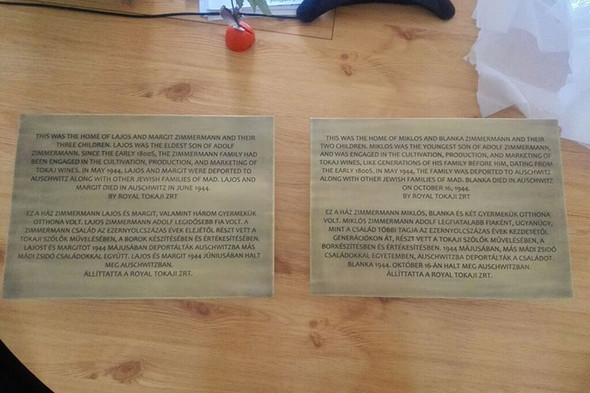The story begins more than a year ago, and concerns our 87-year-old mother, Susy Oster, who currently lives in Long Beach, CA. She grew up in Mád, Hungary, which is in the wine-producing region of Tokaj. Generations of her family—the Zimmermanns—had lived in Mád before her, dating back to at least the early-1800s. The family was renowned as vintners and wine merchants. Their property holdings were extensive, and notably included many of the "first-growth" vineyards in the area.
This came to an abrupt end when our mother and grandmother, as well as our mother’s aunt, uncle, and most of the other members of her large extended family in Hungary, were arrested and deported to Auschwitz-Birkenau in 1944. Most of them perished in concentration camp. Susy was transported from Auschwitz-Birkenau and sent to a slave labor camp. After 7 months at a Siemens factory, Susy was liberated by US troops in 1945.
Her brother, George Zimmermann, was conscripted into a Jewish labor battalion and sent to the Eastern front in 1943. He was captured by the Russians and held prisoner for 5 years. He returned to Mád briefly before escaping to the west and eventually joined his sister in the U.S.
About a year ago, we learned that the home, the cellars and many of the vineyards that belonged to my mother's family are now owned by the Royal Tokaji Wine Company, which is perhaps the best-known wine producer and exporter in the Tokaj region of Hungary today. We became aware of this quite unexpectedly, while planning a trip to Hungary in 2015.
As were planning our trip, we were interested in tours of the wine region. We came upon a tour company—Taste Hungary—that offered a “Tokaj Jewish Heritage & Wine Tour”. There, in their photos, were the headstones of my great grandparents. We contacted the company to arrange a tour. We didn’t know the region was once again producing world-class wines. We began researching wineries in the region worth visiting and came upon Royal Tokaji.
The address looked familiar, and once on Royal Tokaji’s website, we immediately recognized the building as the house in which my mother’s family had lived for generations. The house is especially prominent because it is directly across the street from a monument to persons who died in WWI. In fact, my mother still has an old photo postcard of the monument and the house. Her family’s compound is now the headquarters of Royal Tokaji.
We were troubled, however, because while the company's marketing materials overflowed with information about the rich history of Tokaji wine, there was no mention of the fact that Royal Tokaji's vineyards and cellars and buildings belonged to my mother’s family for generations. In Royal Tokaji's telling of the history of the vineyards and winery, there was a mysterious gap between the 1700s and the Magyars tilling the land and the Communist and post-Communist eras. Yet, with a little digging on the Internet, we found an article published in the Philadelphia Inquirer in the year 2000 that identified Royal Tokaji’s property as having “belonged to the Zimmermanns”. (This same article also stated that the company had "purchased the cellars and house from the Zimmermann family" in 1994. No such transaction ever took place, as my mother and her brother were the only surviving members of the family, and neither of them were parties to any such sale.)
Having discovered this, we approached Royal Tokaji about one year ago and asked them to acknowledge, both on their website and with a plaque on the building, this important part of the history of the vineyards and winery. We also made it clear that we were not seeking any financial restitution.
For months, the company maintained in e-mail exchanges that it knew little about the Zimmermanns beyond the fact that they were "large regional landowners". This seemed puzzling to us, since one of the original investors in Royal Tokaji was one of the world's most famous wine experts (Hugh Johnson). We felt confident that he and the other investors knew that the first-growth vineyards and cellars and winery they were acquiring belonged to a major pre-war producer, most likely a Jewish family that fell victim to the Holocaust. Zimmermann wines were well-known throughout Europe beginning in the mid-1800s, and one can still find wines produced by my ancestors for sale on the Internet.
After months of negotiations, the company finally agreed to publicly acknowledge the Zimmermann family, both by revising historical material on their website (this has already been done) and by placing commemorative plaques on two of their buildings built (one was occupied by my mother's family, and the other, by the family of my grandfather's brother). Attached you will find pictures of the two plaques that will be mounted on the buildings in a small ceremony on June 24, 2016 at 11am, which will be attended by various members of our family.






